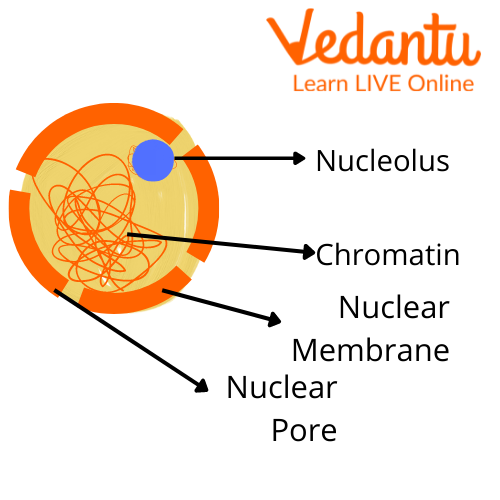




What is Nucleus?
A nucleus can be referred to as the brain of a cell. It is an essential part of a eukaryotic cell. Now let us learn what is a nucleus? It controls the processes happening inside a cell. The nucleus decides what proteins are formed, what organelles are present in the cell, etc.
The nucleus is the most significant structure inside the animal and plant cells. It is the cell's main control centre.

Nucleus
Where is it Present?
A nucleus is usually present in the centre of the cell but may be pushed to the periphery in some cells for various reasons. The nucleus is not found in all cells, though. It can be seen only in eukaryotic cells. A eukaryotic cell is defined by the presence of a nucleus, whereas a prokaryotic cell is determined by the absence of a nucleus.

Location of Nucleus
There is usually a single nucleus in the cell, but many cells are seen with multiple nuclei.
Parts of Nucleus
The nucleus is made of many structures, and each of them has different but specific functions. The parts of a nucleus are:
Nuclear Envelope/Membrane: The nuclear envelope consists of two membranes; the outer membrane and the inner membrane. The nucleus is shielded from the rest of the cytoplasm in the cell by the envelope, which prevents specific molecules within the nucleus from escaping.
Nucleolus: The nucleolus is a huge structure in the nucleus that is responsible for the production of ribosomes and RNA.
Chromatin: Proteins and DNA make up chromatin. Before cell division, they assemble into chromosomes.
Nucleopores: Pores are tiny channels that go through the nuclear envelope. They allow tiny molecules, such as messenger RNA molecules, to pass through while keeping larger DNA molecules inside the nucleus.

Parts of a Nucleus
Structure of Nucleus
The structure of a nucleus is formed of the parts of a nucleus which constitute the organelle. The nucleus is a globular or round organelle mostly found in the centre of a eukaryotic cell and is formed of a double-walled nuclear membrane. The nuclear membrane controls the exchange of substances within the cell and the nucleus. The ribosomes, genetic material, and other proteins lie in the nucleoplasm. The genetic material, mostly DNA, is packed properly into a chromosome.
Functions of Nucleus
Some of the functions of a nucleus are mentioned below.
DNA, which conveys genetic information, is the genetic substance of a cell that lies in the nucleus.
In the synthesis of RNA and ribosomes, the nucleus is crucial.
It is in charge of the cell's entire biological activity.
By directing gene expression, the nucleus aids in cellular differentiation.
Genetic variants also play a significant role in biological evolution.
Cell division and gene replication are controlled by the nucleus.
Conclusion
A cell's nucleus is sometimes referred to as its brain. It is an organelle that regulates internal cellular activities and is a crucial component of eukaryotic cells. What proteins are made and which organelles are present in the cell are determined by the nucleus. It performs similarly to the brain and is the primary control centre of the cell.
FAQs on What Does the Nucleus Do?
1. What are the components of a nucleus, and is the nucleus an organelle?
A nucleus is made up of a nuclear membrane, nucleolus, chromatin, genetic material, ribosomes, and nucleopores. Ribosomes help in the synthesis of protein in a nucleus. Since the prokaryotic cell has no nucleus, the DNA of this kind of cell is located in the cytoplasm.
Any specific structure that performs a distinct function inside a cell is called an organelle. The nucleus is thus also an organelle of a cell. Other organelles are ribosomes, Golgi bodies, mitochondria, plastids, etc.
2. Write some interesting facts about the nucleus.
Some interesting facts about the nucleus are:
Scientists found the nucleus as the first of the cell organelles.
It normally takes up around 10% of the volume of the cell.
Each human cell contains around 6 feet of tightly packed DNA well structured with proteins.
During cell division, the nuclear envelope breaks down, but it reforms once the two cells divide.
Some experts believe that the nucleolus is involved in cell ageing.
Robert Brown, a Scottish botanist, gave the cell nucleus its name.









